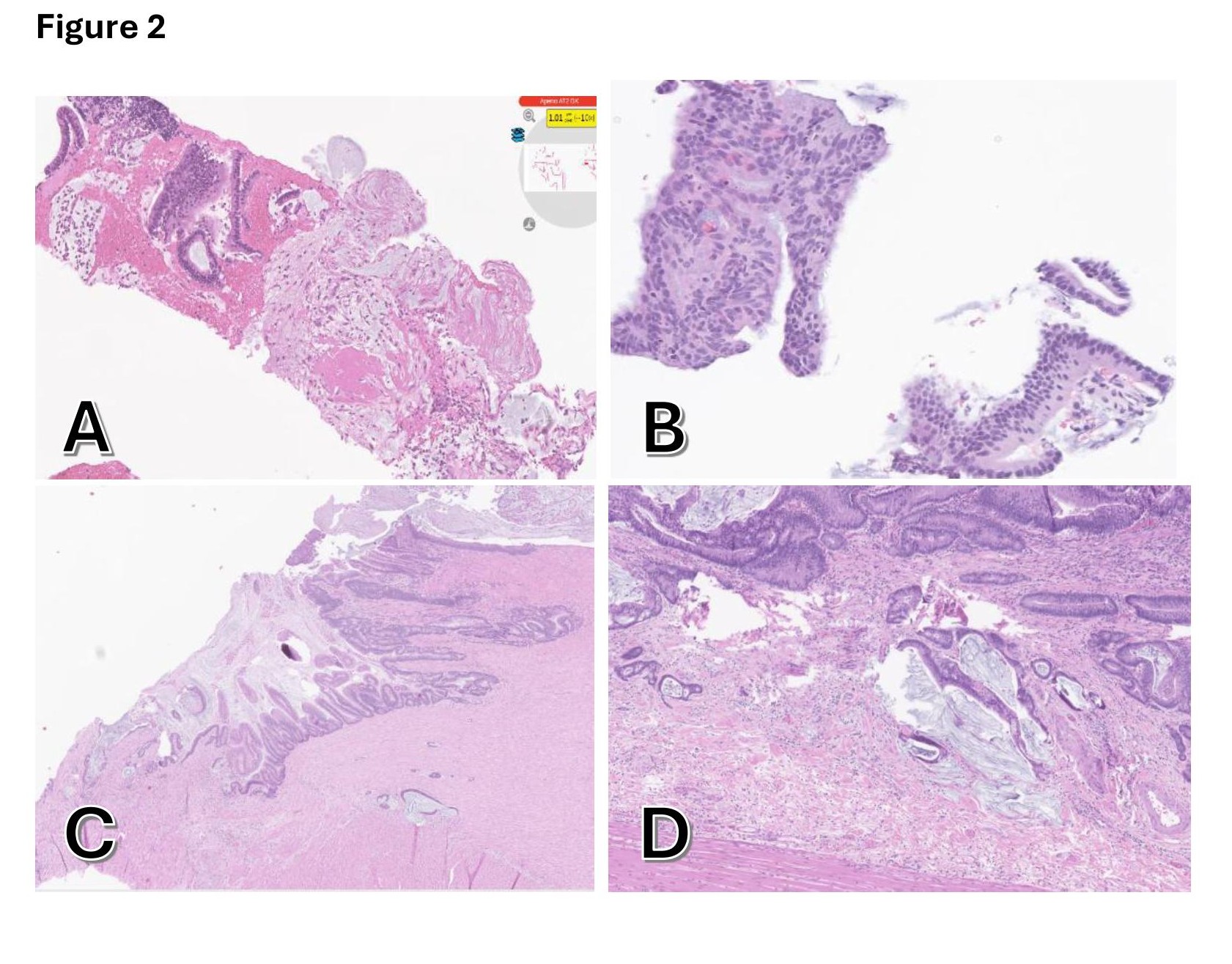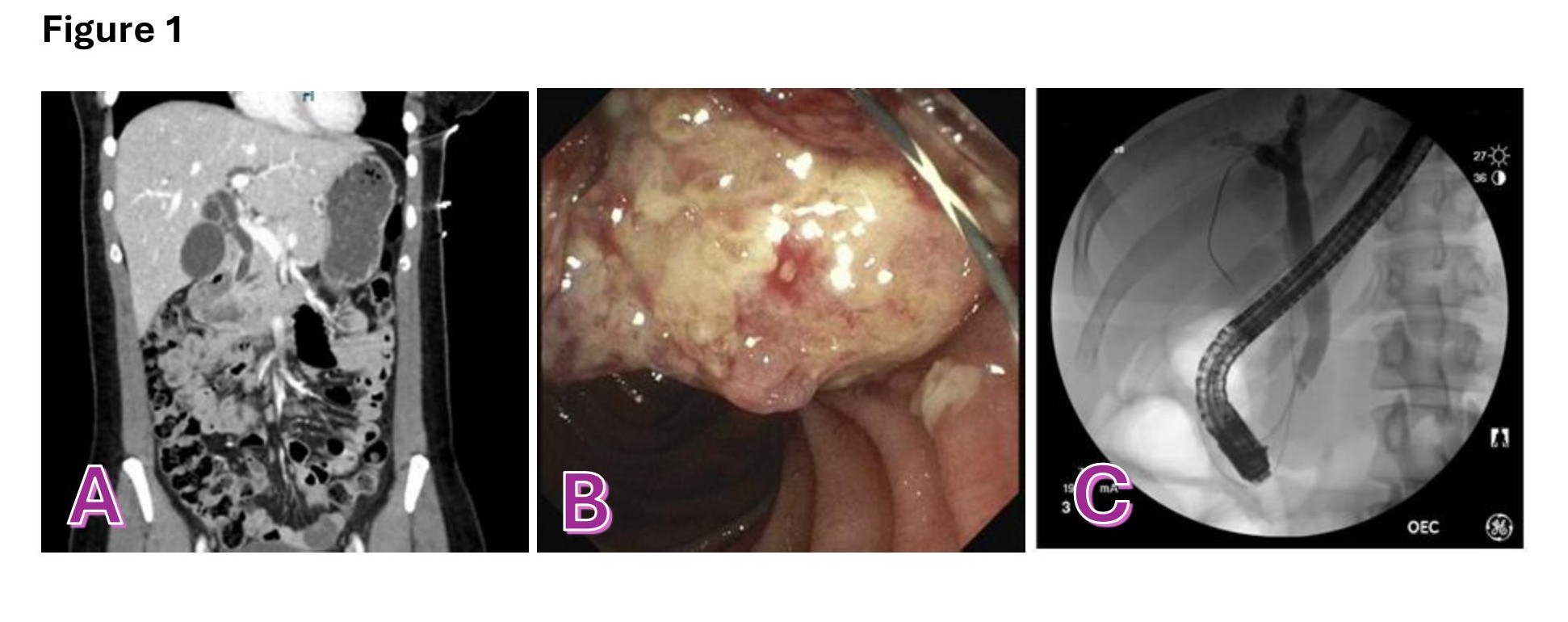Monday Poster Session
Category: Small Intestine
P4164 - BRCA-Associated Ampullary Adenocarcinoma: Expanding the Spectrum of BRCA-Linked Tumors
Monday, October 27, 2025
10:30 AM - 4:00 PM PDT
Location: Exhibit Hall

Sharifeh Almasaid, MD, MPH (she/her/hers)
SUNY Upstate Medical University
Syracuse, NY
Presenting Author(s)
Sharifeh Almasaid, MD, MPH1, Ayushi Jayesh. Shah, MD1, Amanda Eisinger, DO2, Hafiz Muzaffar Akbar Khan, MD3
1SUNY Upstate Medical University, Syracuse, NY; 2SUNY Upstate Medical University Hospital, Syracuse, NY; 3AdventHealth, Tampa, FL
Introduction: BRCA mutations are found in ~2% of hereditary pancreatic cancers, but links to hepatocellular or small bowel cancers are rare. Ampullary tumors, especially in the duodenum, are uncommon and often carry poor prognoses. We present a case of young BRCA2+ patient diagnosed with ampullary adenocarcinoma.
Case Description/
Methods: A 31-year-old African American woman with a known BRCA 2 mutation presented with 3 weeks of painless jaundice, acholic stools, nausea, pruritus, and 45-lb weight loss over 6 months. She had undergone BRCA testing at age 23 due to a family history of breast cancer. Labs showed cholestatic liver injury with AST 173, ALT 298, ALP 1048, total bilirubin 6.5, Direct bilirubin 4.8. Serologies for viral hepatitis, ANA, mitochondrial antibodies, smooth muscle antibodies, total IgG were all normal. A contrasted CT abdomen showed a dilated common bile duct (12 mm) and pancreatic duct dilation (7mm) with pancreatic divisum. CA19-9 and CEA were elevated to 103 and 81.5 respectively. Upper EUS showed 23×20 mm hypoechoic ampullary mass with FNA showing mucinous adenocarcinoma. Due to failed cannulation of the bile duct, biliary drainage was done with EUS-guided rendezvous ERCP, and a biliary stent was placed. Genetic testing of the mass revealed BRCA2L698fs*32, KRAS Q61R, and PD-L1. No metastases were seen in imaging. She underwent elective robotic pancreaticoduodenectomy with dissection of lymph nodes around the hepatic artery and portal vein; pathology showed mucinous type of ampullary adenocarcinoma with nodal metastasis. She underwent adjuvant FOLFIRINOX and remains in remission at 8 months follow-up.
Discussion: Patients with BRCA 2 mutations have a 5–10% lifetime risk of pancreatic cancer, where incidence of duodenal cancers in BRCA involvement remains unclear. Only two prior BRCA2-related ampullary adenocarcinoma cases have been reported, with both patients being in their 40s at the time of diagnosis. We report this case to add to the growing literature of ampullary tumors in BRCA 2 carriers, which may inform screening of these individuals. Our patient did not have any other environmental risk factors for ampullary adenocarcinoma such as advanced age, male gender or smoking; therefore, we attribute her development of ampullary adenocarcinoma to her BRCA 2 mutation.

Figure: A: Coronal CT abdomen showing dilated CBD. The main pancreatic duct is dilated as well.
B: EGD picture showing the ampullary mass
C: ERCP identifying the dilated CBD

Figure: A: A core needle biopsy of the pancreas at 10 X showing prominent extracellular mucin and a strep of atypical epithelium
B: Same pancreatic biopsy at 20X showing detach fragments of highly atypical epithelium with a nuclear crowding and enlargement along with complex architecture
C: Section of the ampullary mass at 2X complex proliferation of highly atypical cells with prominent mucin and small fauci invasion into muscularis propria
D: Higher magnification of ampullary mass biopsy at 5X showing infiltrative glands with fragmentation and prominent mucin
Disclosures:
Sharifeh Almasaid indicated no relevant financial relationships.
Ayushi Shah indicated no relevant financial relationships.
Amanda Eisinger indicated no relevant financial relationships.
Hafiz Muzaffar Akbar Khan indicated no relevant financial relationships.
Sharifeh Almasaid, MD, MPH1, Ayushi Jayesh. Shah, MD1, Amanda Eisinger, DO2, Hafiz Muzaffar Akbar Khan, MD3. P4164 - BRCA-Associated Ampullary Adenocarcinoma: Expanding the Spectrum of BRCA-Linked Tumors, ACG 2025 Annual Scientific Meeting Abstracts. Phoenix, AZ: American College of Gastroenterology.
1SUNY Upstate Medical University, Syracuse, NY; 2SUNY Upstate Medical University Hospital, Syracuse, NY; 3AdventHealth, Tampa, FL
Introduction: BRCA mutations are found in ~2% of hereditary pancreatic cancers, but links to hepatocellular or small bowel cancers are rare. Ampullary tumors, especially in the duodenum, are uncommon and often carry poor prognoses. We present a case of young BRCA2+ patient diagnosed with ampullary adenocarcinoma.
Case Description/
Methods: A 31-year-old African American woman with a known BRCA 2 mutation presented with 3 weeks of painless jaundice, acholic stools, nausea, pruritus, and 45-lb weight loss over 6 months. She had undergone BRCA testing at age 23 due to a family history of breast cancer. Labs showed cholestatic liver injury with AST 173, ALT 298, ALP 1048, total bilirubin 6.5, Direct bilirubin 4.8. Serologies for viral hepatitis, ANA, mitochondrial antibodies, smooth muscle antibodies, total IgG were all normal. A contrasted CT abdomen showed a dilated common bile duct (12 mm) and pancreatic duct dilation (7mm) with pancreatic divisum. CA19-9 and CEA were elevated to 103 and 81.5 respectively. Upper EUS showed 23×20 mm hypoechoic ampullary mass with FNA showing mucinous adenocarcinoma. Due to failed cannulation of the bile duct, biliary drainage was done with EUS-guided rendezvous ERCP, and a biliary stent was placed. Genetic testing of the mass revealed BRCA2L698fs*32, KRAS Q61R, and PD-L1. No metastases were seen in imaging. She underwent elective robotic pancreaticoduodenectomy with dissection of lymph nodes around the hepatic artery and portal vein; pathology showed mucinous type of ampullary adenocarcinoma with nodal metastasis. She underwent adjuvant FOLFIRINOX and remains in remission at 8 months follow-up.
Discussion: Patients with BRCA 2 mutations have a 5–10% lifetime risk of pancreatic cancer, where incidence of duodenal cancers in BRCA involvement remains unclear. Only two prior BRCA2-related ampullary adenocarcinoma cases have been reported, with both patients being in their 40s at the time of diagnosis. We report this case to add to the growing literature of ampullary tumors in BRCA 2 carriers, which may inform screening of these individuals. Our patient did not have any other environmental risk factors for ampullary adenocarcinoma such as advanced age, male gender or smoking; therefore, we attribute her development of ampullary adenocarcinoma to her BRCA 2 mutation.

Figure: A: Coronal CT abdomen showing dilated CBD. The main pancreatic duct is dilated as well.
B: EGD picture showing the ampullary mass
C: ERCP identifying the dilated CBD

Figure: A: A core needle biopsy of the pancreas at 10 X showing prominent extracellular mucin and a strep of atypical epithelium
B: Same pancreatic biopsy at 20X showing detach fragments of highly atypical epithelium with a nuclear crowding and enlargement along with complex architecture
C: Section of the ampullary mass at 2X complex proliferation of highly atypical cells with prominent mucin and small fauci invasion into muscularis propria
D: Higher magnification of ampullary mass biopsy at 5X showing infiltrative glands with fragmentation and prominent mucin
Disclosures:
Sharifeh Almasaid indicated no relevant financial relationships.
Ayushi Shah indicated no relevant financial relationships.
Amanda Eisinger indicated no relevant financial relationships.
Hafiz Muzaffar Akbar Khan indicated no relevant financial relationships.
Sharifeh Almasaid, MD, MPH1, Ayushi Jayesh. Shah, MD1, Amanda Eisinger, DO2, Hafiz Muzaffar Akbar Khan, MD3. P4164 - BRCA-Associated Ampullary Adenocarcinoma: Expanding the Spectrum of BRCA-Linked Tumors, ACG 2025 Annual Scientific Meeting Abstracts. Phoenix, AZ: American College of Gastroenterology.
